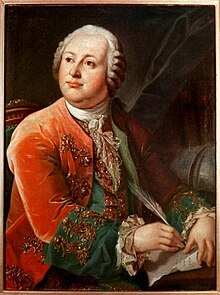Mikhail Lomonosov | |
|---|---|
Михаил Ломоносов | |
 Portrait by G. Prenner, 1787 | |
| Born | Mikhail Vasilyevich Lomonosov 19 November 1711 Mishaninskaya, Russia |
| Died | 15 April 1765 (aged 53) Saint Petersburg, Russia |
| Alma mater | Slavic Greek Latin Academy St. Petersburg Academy University of Marburg |
| Spouse | Elizabeth Christine Zilch |
| Scientific career | |
| Fields | Natural science, Astronomy, chemistry, physics, physical chemistry, geology, geophysics, mineralogy, history, philology, optics |
| Institutions | St. Petersburg Academy |
| Academic advisors | Christian Wolff |
| Signature | |
Mikhail Vasilyevich Lomonosov (/ˌlɒməˈnɒsɒf/;[1] Russian: Михаил Васильевич Ломоносов, IPA: [mʲɪxɐˈil vɐˈsʲilʲjɪvʲɪtɕ ləmɐˈnosəf] ; 19 November [O.S. 8 November] 1711 – 15 April [O.S. 4 April] 1765) was a Russian polymath, scientist and writer, who made important contributions to literature, education, and science. Among his discoveries were the atmosphere of Venus and the law of conservation of mass in chemical reactions. His spheres of science were natural science, chemistry, physics, mineralogy, history, art, philology, optical devices and others. The founder of modern geology,[2][3] Lomonosov was also a poet and influenced the formation of the modern Russian literary language.
- ^ "Lomonosov". Random House Webster's Unabridged Dictionary.
- ^ Lomonosov, Mikhail (2012). On the Strata of the Earth. Translation and commentary by S.M. Rowland and S. Korolev. The Geological Society of America, Special Paper 485. ISBN 978-0-8137-2485-0.
- ^ Vernadsky, V. (1911) Pamyati M.V. Lomonosova. Zaprosy zhizni, 5: 257-262 (in Russian) [In memory of M.V. Lomonosov]